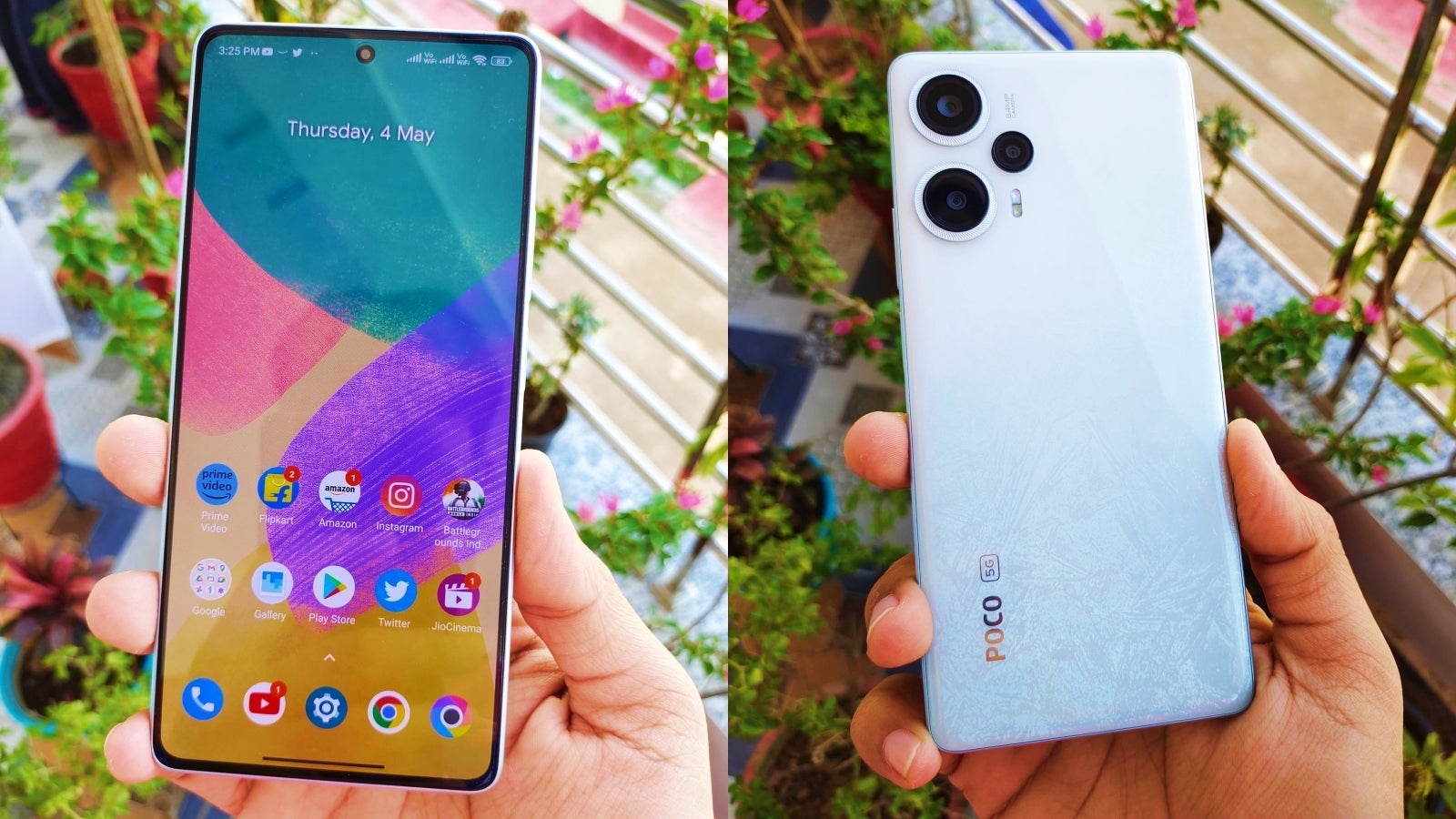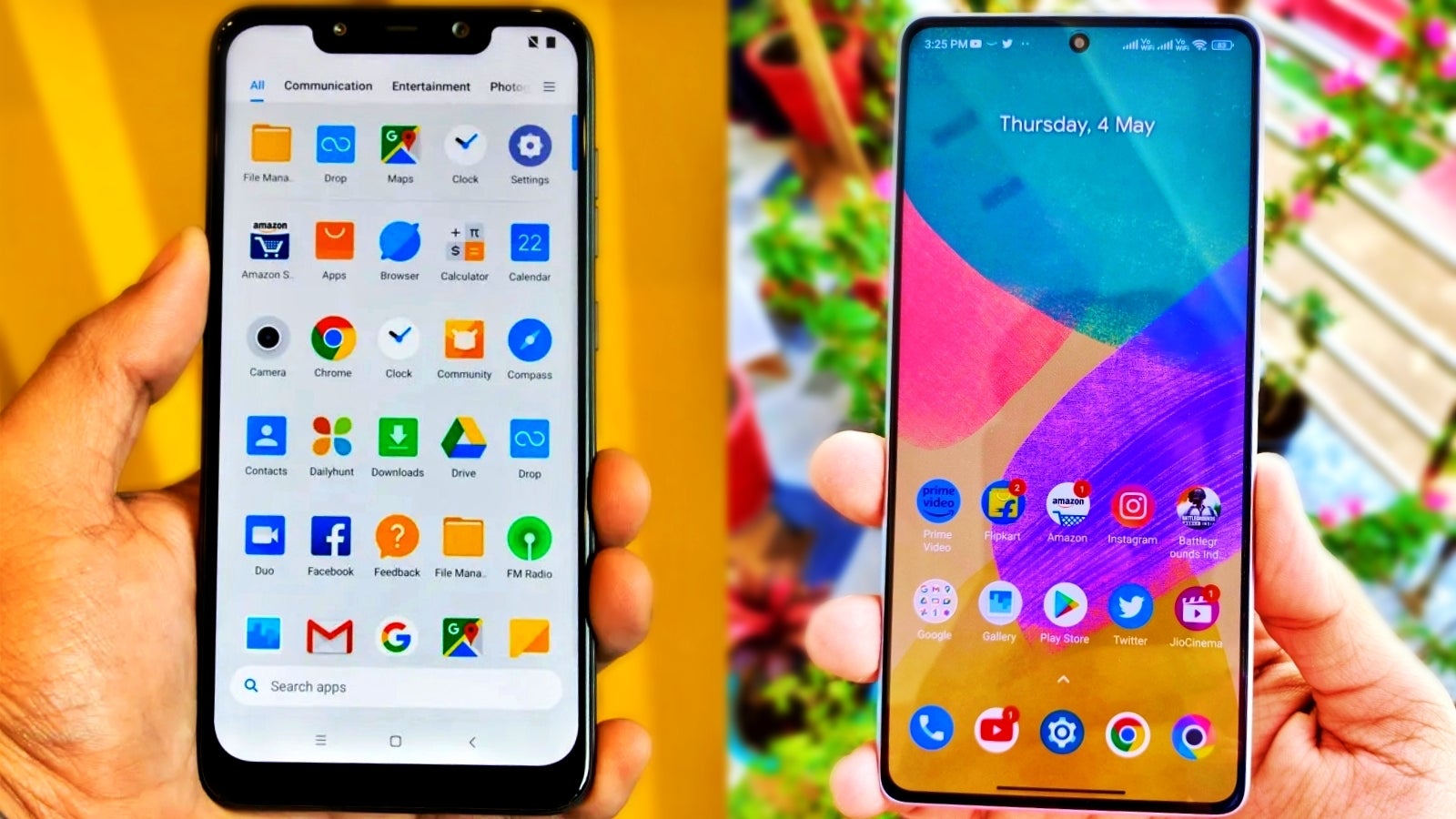Step aside, Pixel 7a, Galaxy A54! This phone breaks the records for best display, best chip for $400
This article may contain personal views and opinion from the author.

Without a shadow of a doubt, the Pixel 7a and Galaxy A54 are two of the best value phones available on the market today. In fact, the brand new $500 Pixel 7a would (still) be my personal pick for the best value mid-range phone to buy right now.
However, Google’s nicely packaged $500 Pixel 7a and Samsung’s $450 Galaxy A54 aren’t exactly phones that push the boundaries of what a $400-500 mid-range device could look like. For example, the two truly standout features of each of them are the Pixel 7a’s flagship-grade camera, and the Galaxy A54’s flagship-grade software support (4 years of OS updates). And that’s where a phone like the new Poco F5 comes in.
You might recall that after OnePlus, Xiaomi was the next phone-maker that showed us what a “real flagship-killer” looks like with the original “F” series phone that took the smartphone world by storm, the Poco F1.
Now, nearly five years later, the Poco F5 proves Xiaomi’s mission to bring flagship-grade performance to the mid-range segment is far from complete. The new $400 Poco F5 doesn't only look better than the Pixel 7a and Galaxy A54, but also when compared to some $1,000 flagships! The cherry on top? It’s also as powerful as a true Android flagship. No, really.
Right out the gate, what stands out about the Poco F5 is how Xiaomi’s managed to give it what’s probably the best-looking display on a mid-range phone (likely) ever. Like ever ever. We're talking a bright 6.67-inch OLED panel with a 120Hz refresh rate but what really puts it over the mid-range line (and into flagship territory) are the super-slim, symmetrical display borders.
Now, nearly five years later, the Poco F5 proves Xiaomi’s mission to bring flagship-grade performance to the mid-range segment is far from complete. The new $400 Poco F5 doesn't only look better than the Pixel 7a and Galaxy A54, but also when compared to some $1,000 flagships! The cherry on top? It’s also as powerful as a true Android flagship. No, really.
Although the Poco F5 isn’t coming to the US, it still has a good chance at shaking up the European and British markets, showing Samsung and Google what’s possible for just $400. And I don't know about you but I'm certainly impressed by the records this affordable phone sets.
History in the making! Galaxy A54 and Pixel 7a can’t compete with $400 Poco F5, which brings the best display and fastest processor ever in a mid-range Android phone
Right out the gate, what stands out about the Poco F5 is how Xiaomi’s managed to give it what’s probably the best-looking display on a mid-range phone (likely) ever. Like ever ever. We're talking a bright 6.67-inch OLED panel with a 120Hz refresh rate but what really puts it over the mid-range line (and into flagship territory) are the super-slim, symmetrical display borders.
The incredible front look makes the Poco F5 look better than many $1,000 phones, and certainly more premium than the Pixel 7a and Galaxy A54, which are competing for the thickest display borders in the $500 segment. Not a particularly great look for the Samoogle partners.
Again, I don’t know if I can stress that enough, but this is the best-looking display I've ever seen in a $400 phone, which isn’t something to skimp on. Technically, the display is the most used “feature” of your smartphone, which is why some would argue it’s also the most important one.
Again, I don’t know if I can stress that enough, but this is the best-looking display I've ever seen in a $400 phone, which isn’t something to skimp on. Technically, the display is the most used “feature” of your smartphone, which is why some would argue it’s also the most important one.
Galaxy A54 and Pixel 7a are no match for the Poco F5 and the Snapdragon 7+ Gen 2 in terms of performance; Xiaomi and Qualcomm set new records for Android

But Xiaomi isn’t done breaking records. The Poco F5 is also the first phone that uses Qualcomm’s brand new Snapdragon 7+ Gen 2 chip, and you’d think we have the usual drill here - a mid-range SoC for a mid-range phone but you’d be dead wrong.
- Poco F5 is noticeably more powerful than the Tensor G2-powered Google Pixel 7a; respectively, this $400 phone also beats the likes of the Pixel 7 and Pixel 7 Pro, which costs $600-900
- Poco F5 smokes the Galaxy A54’s Exynos 1380 chip, which has been known to hold mid-range Samsung phones back in terms of smoothness and performance; while benchmarks aren't always indicative of how well a phone performs, this time that's not the case
- The $400 Poco F5 is now the fastest new Android phone on the market, save for flagships like the Galaxy S23 Ultra, OnePlus 11, and Xiaomi 13 Ultra, or in other words, phones with the latest Snapdragon 8 Gen 2 SoC
The reason the new Snapdragon 7+ Gen 2 performs like a true flagship chip is because… it really is a true flagship chip. It makes you wonder why more Android phones aren’t using the new Snapdragon 7+ Gen 2 in their mid-range phones.
Built almost exactly like a Snapdragon 8+ Gen 1, the 7+ Gen 2 appears to be an underclocked version of Qualcomm’s former flagship SoC. The only difference between the two seems to be in the clock speeds of their respective prime cores (3.0GHz vs 2.8Ghz), and the integrated GPU (Adreno 730 vs Adreno 725).
Combined with 12GB of fast RAM and Dynamic RAM Expansion, which can use the phone’s storage to expand RAM up to 19GB, the Poco F5 basically brings $800 worth of performance for only $400, which is unheard of even for Xiaomi phones, let alone the $400 smartphone segment in general.
Combined with 12GB of fast RAM and Dynamic RAM Expansion, which can use the phone’s storage to expand RAM up to 19GB, the Poco F5 basically brings $800 worth of performance for only $400, which is unheard of even for Xiaomi phones, let alone the $400 smartphone segment in general.
The cherry on top? The Poco F5 and Snapdragon 7+ Gen 2 are also able to sustain their high performance for longer than other mid-range phones. According to early tests, Xiaomi’s excellent Vapor Chamber Cooling in combination with the lower clock speeds seem to be working wonders in keeping the phone cool even in gaming sessions, which is rare for $1,000 devices, let alone for a $400 one.
Poco F5 brings 2x optical quality zoom, a long-lasting battery, true fast-charging, and generous 256GB of storage for only $400; match that, Samsung and Google!

And while the flagship-grade display and performance are the standout features of the new Poco F5, there are even more great reasons European, British, and Indian users might want to consider this $400 phone over others...
- Poco F5 has amazing battery life and real fast charging - the Poco F5 comes with a huge 5,000 mAh battery, matching phones like the Galaxy A54 and Galaxy S23 Ultra, and much larger than the one in Pixel 7a; the Poco F5 did excellent in our battery tests, which you can see in our Poco F5 review; where the F5 wins big time is in charging - the 67W charger (which comes in the box), charges the phone from 0 to 100% in about 40 minutes; sure, there’s no wireless charging here but I think the fast charging and the price make up for it
- Poco F5 gives you 256GB storage by default- although the Poco F5 doesn’t come with a micro-SD card slot (like a Galaxy A54, for example), Xiaomi has been very generous, giving the base variant of the phone 256GB of storage, which is double that of the Pixel 7a, Galaxy A54, Galaxy S23 Ultra, iPhone 14 Pro - you name it
- IP53 water and dust protection - although you’d expect a $400 Android phone that has the best display and chipset in this price segment might skimp on water protection, Xiaomi has managed to give the Poco F5 an IP53 splash/dust resistance rating, which means you should be able to use it in the rain (don’t drop it in the toilet though)
- Poco F5 also has a "zoom camera" - another thing we rarely see in a mid-range phone is any form of optical zoom, and although Xiaomi hasn’t equipped the Poco F5 with a dedicated telephoto lens, it uses the same sensor-cropping trick used in phones like iPhone 14 Pro and Pixel 7 Pro to give you 2x “optical quality” zoom, which is awesome at this price point - you effectively get an extra camera for photos
- Poco F5 has actual stereo speakers - another great perk of the Poco F5 is the stereo speakers on board, which unlike in virtually every other non-Xiaomi phone, are done properly; the Poco F5 has dedicated speaker grills on the top and bottom instead of using the earpiece as a second speaker, which means you get stereo sound “the way God intended”; although the Poco F5’s speakers aren’t better than those of flagships like the iPhone 14 Pro Max, the sound is balanced (for obvious reasons)
Ironically, the Google Camera app is the only way Poco F5 can beat Pixel 7a when it comes to photography - it works like magic!
Now, while some omissions like the lack of wireless charging and IP67 rating have been sort of made up for by the presence of fast wired charging and an IP53 rating, Xiaomi’s mid-ranger has a few weak links that might bother some users. But there are workarounds.
The first one is the camera, and despite looking impressive on paper, the Poco F5’s 64MP primary, 8MP ultra-wide, and 2MP macro shooters take good photos at best. The results in more challenging lighting conditions fall behind the flagships of the day. If the Poco F5 gets close to the Galaxy A54, it doesn’t quite match the Pixel 7a in the camera department - but then again, which other mid-range phone does...
The great news is that there is a very interesting way to“fix” the average photos the Poco F5 takes, which is called (hold for the irony), “Google Camera”.
If you didn’t know, developers online use the default Google Camera app from phones like the Pixel 7 Pro to create different versions of it that can be installed on various phones that run on a Qualcomm chips, like the Poco F5. Installing this app happens from a third-party website and not from the PlayStore but it’s super simple. Of course, you do it on your risk. As the phone is still very new, there isn’t a Google Camera APK for the Poco F5 just yet, but rest assured this one will pop up very soon.
As you can tell from the photo samples comparing the default camera in last year’s Poco F4 and the same pictures taken in the Google Camera app, the difference in quality can be staggering. So, in a way, the Poco F5 might very well be able to take photos that look suspiciously similar to those coming from a Pixel 7a, which is... bonkers. Is it a perfect solution? No. Is it amazing that it's even possible? Yes, totally.
Outside of the lack of US availability (it is what it is), the second obvious drawback of Xiaomi phones is the lack of reliable software support. Don't get me wrong - it’s not like they don’t get updates but they are certainly behind the competition in terms of longevity and timeliness, and the Poco F5 is no different.
Xiaomi promises only two years of major Android updates for the Poco F5, and three years of security patches, which should come every three months (or every quarter). In comparison, Google offers three years of OS updates and five years of security patches, while Samsung tops that at four years of OS updates and five years of security patches.
If you’re someone who upgrades their phone every two years (many do), this might not be a big problem. However, the general trend today is that people keep their devices for longer (about three years), which is why it would’ve been great to see a promise for at least three Android updates here. This would make the next Poco F6 even easier to recommend.
Xiaomi’s biggest problems remains software support and US availability; this affects the excellent Poco F5 too
Outside of the lack of US availability (it is what it is), the second obvious drawback of Xiaomi phones is the lack of reliable software support. Don't get me wrong - it’s not like they don’t get updates but they are certainly behind the competition in terms of longevity and timeliness, and the Poco F5 is no different.
Xiaomi promises only two years of major Android updates for the Poco F5, and three years of security patches, which should come every three months (or every quarter). In comparison, Google offers three years of OS updates and five years of security patches, while Samsung tops that at four years of OS updates and five years of security patches.
If you’re someone who upgrades their phone every two years (many do), this might not be a big problem. However, the general trend today is that people keep their devices for longer (about three years), which is why it would’ve been great to see a promise for at least three Android updates here. This would make the next Poco F6 even easier to recommend.
Let's give mid-range phones at least three years of Android OS upgrades, Xiaomi?
Poco F5 proves mid-range phones no longer have to settle for mediocre performance and design; Xiaomi made the best $400 mid-range phone ever

Poco F1 (2018) and Poco F5 (2023)
Finally, I see a pattern with Xiaomi’s “F” series of phones, and the pattern I see with the Poco F5 is that, unlike past years when $400 phones had to settle for mediocre specs (which reflected their mid-range price), Xiaomi is bringing a whole different attitude to the mid-range segment.
The Poco F5 doesn’t settle for mediocrity but for “the next best thing”. Let's hope this becomes the new motto for mid-range Android phones from now on!
- No 2000 nits of max brightness and an in-display fingerprint reader? Next best thing - also a very bright display but with super thin display borders; fingerprint reader in the power button
- No Snapdragon 8 Gen 2? What’s the next best thing? The Snapdragon 7+ Gen 2 - let’s get that instead of a cheaper MediaTek chip, says Xiaomi
- No dedicated zoom lens like the ones in $1,000 phones? Let’s take full advantage of the high-res 64MP camera and give people 2x lossless zoom
- No wireless charging? The next best thing would be fast wired charging and a 67W fast charger in the box
- No IP67 water and dust-resistance? The next best thing would be a basic IP53 dust and splash-resistance
After all of that some of you might ask: “Martin, if the Poco F5 is such a great phone, would you actually buy it?”, and the answer is… maybe. My personal hesitation boils down to my appreciation for an excellent camera and extended software support. However, that doesn’t mean I still don’t think the Poco F5 is a very important smartphone.
More importantly, not everyone cares about the “absolute best camera”, and trust me when I say it, most people don’t even know how many years of software support their phone is supposed to get. They go into the store, hold up two phones next to each other and pick the one that happens to fit better in the hand.
If you think about it, the mid-range Poco F5 has a similar role to a totally different beast of a phone like the folding Huawei Mate X3. Just like the Mate X3 exists to push the boundaries in the foldable segment, the Poco F5 proves Samsung and Google aren’t necessarily giving us the best mid-range Android package possible. Especially when it comes to display, performance, and charging.
Let’s see if the Poco F6 manages to bring a great camera and at least three years of Android updates to climb to the top of the mid-range smartphone chain.










Things that are NOT allowed: